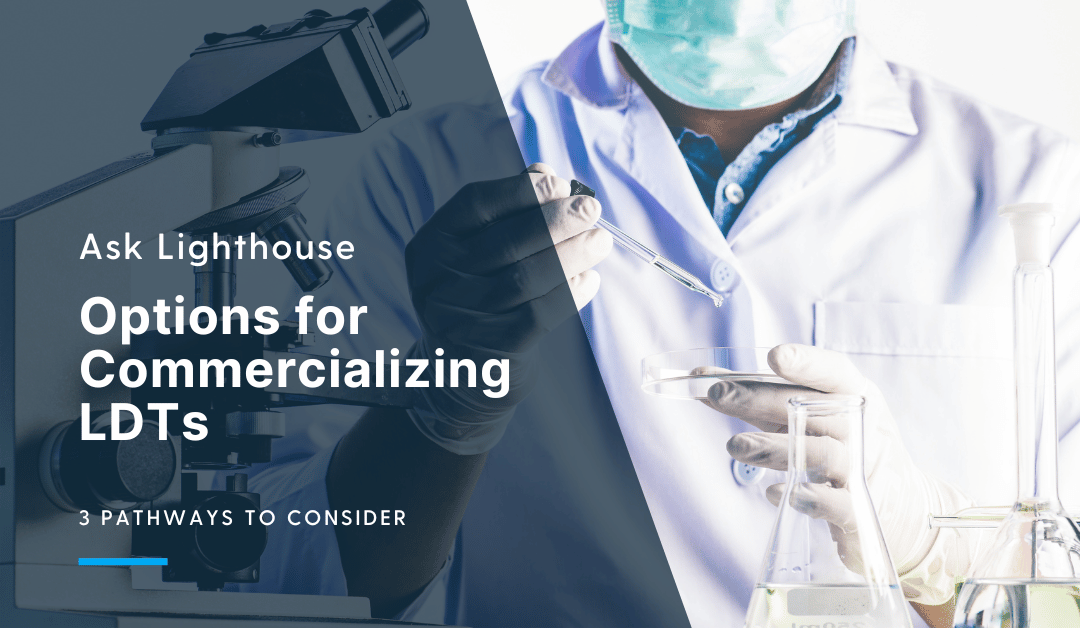UPDATE: On May 6, 2024, FDA issued a new rule amending the regulatory definition of in vitro diagnostic (IVD) device to include laboratory-developed tests (LDTs) and ending the agency’s longstanding policy of generalized enforcement discretion. Learn more about these new rules and how Lighthouse can help you comply with them here.
So, your lab’s research and development team has made a new scientific discovery for a laboratory test that you would like to bring to market. Congratulations! But what pathways are available to you, and what are the next steps in monetizing your discovery?
While labs interested in broadly distributing their test may want to explore gaining full FDA approval to market it as an in vitro diagnostic test (IVD), that process can be both costly and time consuming, taking up to three to five years in some cases. However, labs interested in offering their discovery sooner should consider the sometimes-overlooked path of commercializing their test as a laboratory developed test (LDT).
An LDT is a test that is designed, manufactured, and used within a single laboratory (potentially across multiple locations). The test must be approved by the lab’s Medical Director and be supported by robust clinical validation studies. Although the test must be marked as being for Research Use Only for distribution purposes and can only be performed by a lab that clinically validated it, there are still multiple options to consider.
“Even if you pursue the path of getting full FDA approval, don’t just sit on your discovery for three to five years while working through that process,” advises Jon Harol, President of Lighthouse Lab Services. “Most groups can’t afford to exist as an entity for that long without getting some kind of revenue in the door, which is why it’s worth exploring an LDT offering.”
With a faster time to market, LDT offerings allow labs to realize a quicker return on their investment and see the fruits of their efforts. Interested in learning more? Here are three primary pathways to consider before commercializing your test as an LDT:
1. Build your own reference lab
Building your own reference lab to offer an LDT allows labs interested in your test to send samples to you for processing. However, keep in mind that this option will require capital up front to get the lab running. You will also need to establish insurance contracts, hire laboratory staff, and consider other startup variables. By doing so, you will then also be able to offer testing options beyond just your new LDT.
“It’s a good option if you have the capital,” Harol says. “While this is a great pathway to consider, you’re also committing to putting resources behind it.”
- RELATED ARTICLE: How Much Does It Cost to Build a Clinical Lab?
2. Partner with an existing CLIA laboratory
Alternatively, you can look to partner with existing CLIA laboratories that have the necessary equipment and staff in-house to run your LDT. Those labs would then offer your test after all parties reach a revenue sharing agreement.
“This is a good way to test your offering out for market fit and proof of concept,” Harol says. “Then, once testing volume gets to a sustainable level, you can start to consider building your own lab.”
Lighthouse often assists in this process by matching labs with equipment on hand with groups offering a new LDT. Our team works with 1,500 CLIA labs and offers consulting agreements for matchmaking.
3. Buy an existing lab
Some groups, especially those with investors, may not face the same capital restraints as others and may be motivated to get their test to market in the most efficient way possible. These groups should consider buying an existing CLIA lab and leveraging the lab’s existing operations and relationships.
“If you build a lab, that doesn’t mean you will instantly have insurance contracts, a salesforce, or relationships with healthcare providers,” Harol points out. “It can be costly, but this route allows you to add your LDT to an existing test menu and hit the ground running.”
Next steps
While this article represents a broad overview of the options available to groups seeking to commercialize a new LDT, you should still discuss your plan with legal representation prior to doing so. Keep in mind that there are numerous considerations regarding how to compliantly approach distribution of your test.
One vitally important note to remember is that while LDTs may be distributed for Research Use Only, the distributing lab may not assist with clinical validation.
If you are seeking a third-party consultant to assist with validations, Lighthouse is happy to connect you with a qualified partner. We have successfully helped clients with compliantly bringing international lab tests into the U.S., the tech transfer of scientific discoveries out of academia, and the commercialization of de novo lab tests from biotech and pharma into the clinical diagnostic space.
Contact us today for a free consultation.
